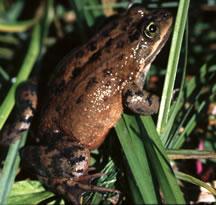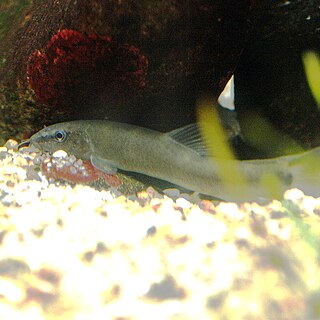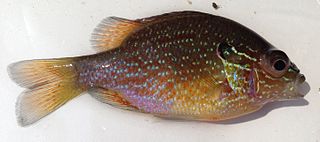
Cobitidae, also known as the True loaches, is a family of Old World freshwater fish. They occur throughout Eurasia and in Morocco, and inhabit riverine ecosystems. Today, most "loaches" are placed in other families. The family includes about 260 described species. New species are being described regularly.

The spined loach is a common freshwater fish in Europe. It is sometimes known as spotted weather loach, not to be confused with the "typical" weather loaches of the genus Misgurnus. This is the type species of the spiny loach genus (Cobitis) and the true loach family (Cobitidae).

The pond loach, also known as the Dojo loach, oriental weatherloach or oriental weatherfish, is a freshwater fish in the loach family Cobitidae. They are native to East Asia, but are also popular as an aquarium fish and introduced elsewhere in Asia and to Europe, America and Australia. The alternate name weather loach is shared with several other Cobitidae, including the other members of the genus Misgurnus and the spotted weather loach. This term comes from their ability to detect changes in barometric pressure before a storm and react with frantic swimming or standing on end.

The Arctic lamprey, also known as the Japanese river lamprey or Japanese lampern, is a species of lamprey, a jawless fish in the order Petromyzontiformes. It inhabits coastal freshwater habitat types in the Arctic. Some populations are anadromous, spending part of their lives in the ocean. It is the most common and widespread lamprey in the Arctic region.

The black redhorse is a species of freshwater fish endemic to Ontario and the eastern half of the United States, where it lives in streams and small to medium rivers.

Misgurnus is a genus of true loaches found in Europe and Asia. The origin of the name Misgurnus comes from the Greek word miseo and the Turkish gür (loud), a name given to them due to their habit of becoming very active during barometric pressure changes that occur during thunderstorms. The common names, weather loach or weatherfish, also derive from this behavior. Some species of misgurnus are eaten, mostly in Asia, and are also sold as pets in the aquarium trade. Their average size can range from 6 to over 12 inches.

Hoplosternum littorale is a species of catfish belonging to the Callichthyinae subfamily of the family Callichthyidae. It is known as tamuatá in Brazil, atipa in French Guiana, hassa in Guyana, kwi kwi in Suriname, cascadu or cascadura in Trinidad and Tobago, and busco or currito in Venezuela.

The Oregon spotted frog is a member of the frog family Ranidae of order Anura. It is a medium-sized aquatic frog endemic to the Pacific Northwest and historically well distributed in the Puget Trough/Willamette Valley province and the Cascade Mountains of south-central Washington and Oregon. It is relatively rare within its range and is listed globally as vulnerable.

The ayumodoki or kissing loach is a species of ray-finned fish in the family Botiidae. It is found in lakes and streams on Honshu, the largest island in Japan. Spawning grounds for kissing loach are ditches and small reservoirs for rice cultivation of a river system located in Japan. The kissing loach migrates to flooded areas, including paddy field areas, for spawning in early summer and the spawning of this species is limited after the formation of flooded areas over terrestrial vegetation. These flooded areas are the result of water from mountain streams and irrigation ponds flooding once dry land which create creating man-made wetlands. As, adults, Parabotia curtus migrate from these flooded paddy fields to fast moving, muddy streams and rivers like the Yodo River.

The stone loach is a European species of fresh water ray-finned fish in the family Nemacheilidae. It is one of nineteen species in the genus Barbatula. Stone loaches live amongst the gravel and stones of fast flowing water where they can search for food. The most distinctive feature of this small fish is the presence of barbels around the bottom jaw, which they use to detect their invertebrate prey. The body is a mixture of brown, green and yellow.

The Bellinger River turtle is a species of turtle in the family Chelidae. The species is of moderate size, with a straight-line carapace length to 240 mm (9.4 in) in females, and 185 mm (7.3 in) in males. It is endemic to Australia with a highly restricted distribution to the small coastal drainage of the Bellinger River in New South Wales. In the past the species was considered locally abundant. The species' preferred habitat is the deeper pools of the clear-water upstream reaches of the river, where water flows continuously in most months over a bedrock basement and a stream bed of boulders, pebbles, and gravel. A captive breeding program has been under way since a 2015 virus outbreak came close to wiping out the entire species. Most remaining individuals are currently housed in quarantine, though a small number have been reintroduced to the original habitat.

The banded pygmy sunfish, Elassoma zonatum, is a species of pygmy sunfish endemic to the United States, where it is found from Indiana and Illinois to Texas to the Atlantic coast. It prefers densely vegetated bodies of slow-moving water. This species can reach 4.7 cm (1.9 in) in total length, though most do not exceed 3.5 cm (1.4 in).

The Modoc sucker is a rare species of freshwater fish native to northern California and southern Oregon. It grows to a length of about 7 in (18 cm) and becomes sexually mature at 4 in (10 cm). It feeds on algae, small invertebrates and detritus, and hides under stones, detritus and overhanging vegetation. It is found in only a few streams and is listed as an endangered species in California and the United States. Conservation measures have been put in place such as fencing the streams in which it lives from livestock. It was previously rated as "endangered" by the International Union for Conservation of Nature, but this rating has now been changed to "near threatened".

The creek chubsucker is a freshwater fish of the sucker family (Catostomidae).

Ameiurus platycephalus, the flat bullhead, is a species of North American freshwater catfish native to the waters of the southeastern United States from Virginia to Georgia. This species grows to a maximum length of 29 cm (11 in) TL though it is more commonly about 23 cm (9 in) long.

Gobio gobio, or the gudgeon, is a species of fish in the family Cyprinidae. This small fish is widely distributed in fresh-water streams and lakes across central and temperate Eurasia.

The dollar sunfish is a species of freshwater fish in the sunfish family of order Perciformes. It is categorized as a warm water pan-fish. Early settlers said that this species of sunfish resembled a European species they called bream. Historically it has been found along the Southern Atlantic coastal drainages from North Carolina to Florida, and west to Texas. Lepomis marginatus mainly feeds on detritus and filamentous algae as well as a few terrestrial insects. The juvenile and mature fish do not have many predators, but the eggs in the nest are in danger of predation from a few different species of fish.
The large-scale loach is a species of true loach that is native to Mainland China, Hainan, Taiwan, Korea, and the Russian Far East. It can be found in water bodies such as the Yangtze Basin, Pearl River, Amur River, and various other drainages. There are several known invasive populations in places such as Barcelona, the San Joaquin River in California, and the majority of Japan. The large-scale loach is typically brown, grey, or golden in color with mottled or speckled black dots, which leads to it sometimes called a "peppered loach" when sold at pet stores. It is a small loach, growing between 7.3 to 15.4 cm TL.
The Marathon minnow is a species of freshwater ray-finned fish from the family Cyprinidae, the carps and minnows. It is endemic to Greece.
Enteral respiration, also referred to as cloacal respiration or intestinal respiration, is a form of respiration in which gas exchange occurs across the epithelia of the enteral system, usually in the caudal cavity (cloaca). This is used in various species as an alternative respiration mechanism in hypoxic environments as a means to supplement blood oxygen.




















